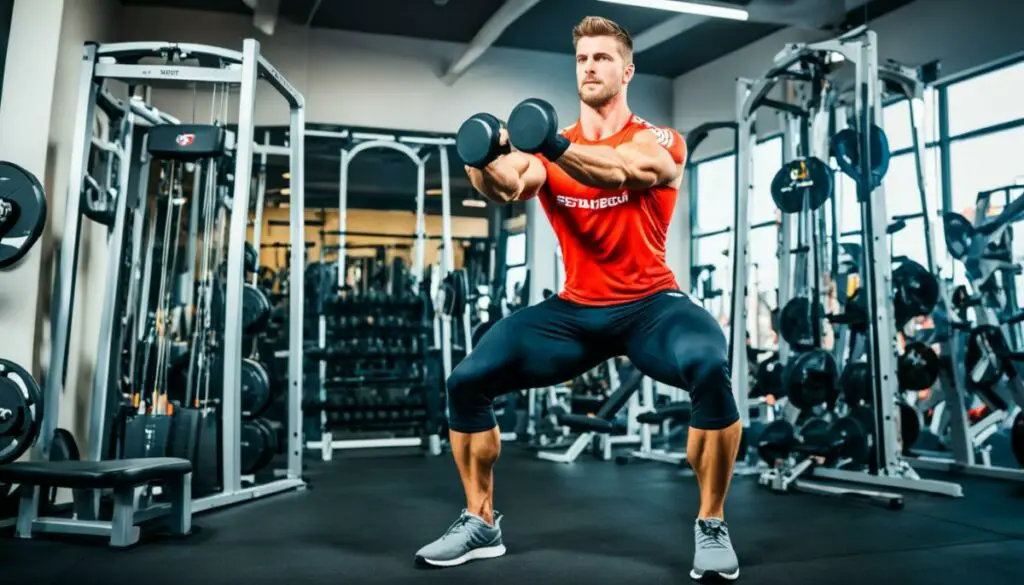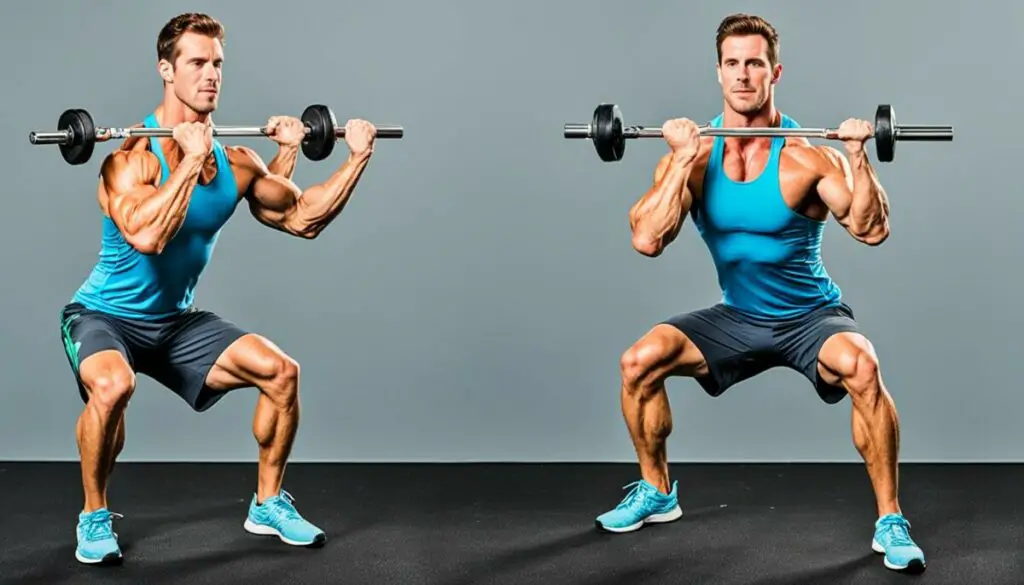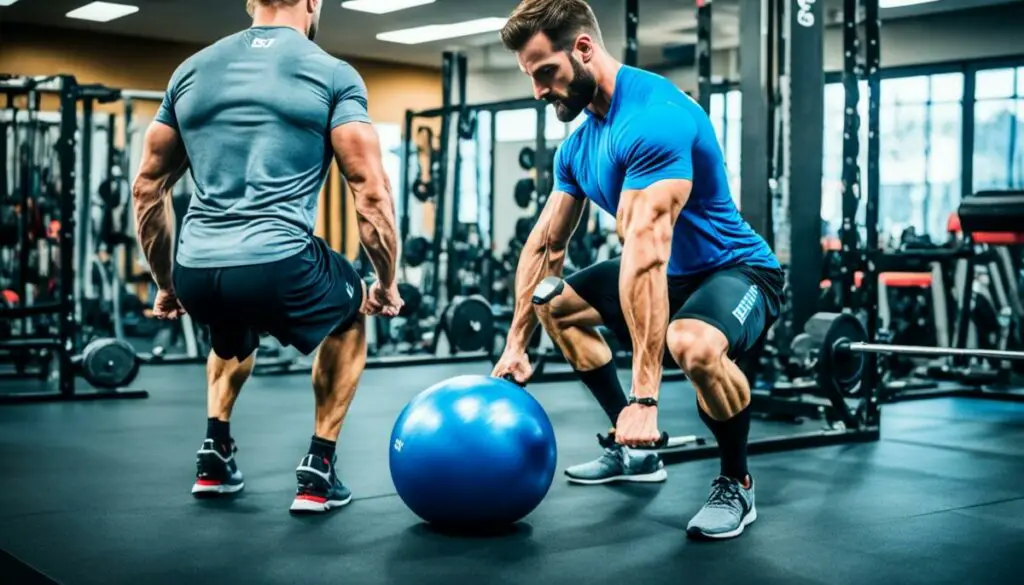Last Updated on 3 months by Francis
The Bulgarian split squat is a powerful exercise that can greatly benefit your fitness routine. By incorporating this exercise into your workout regimen, you can experience improved strength, balance, and flexibility in your lower body. The Bulgarian split squat specifically targets key muscle groups like the quads, hamstrings, glutes, and calves, providing a comprehensive workout for these areas.
Benefits of the Bulgarian split squat include increased muscle activation, improved lower body function, and enhanced joint health. This exercise can help you achieve better overall strength and muscle tone in your lower body, leading to a more empowered and confident you.
Contents
Key Takeaways:
- Bulgarian split squats are an effective exercise for building strength, balance, and flexibility in the lower body.
- This exercise targets key muscle groups like the quads, hamstrings, glutes, and calves.
- Incorporating Bulgarian split squats into your fitness routine can lead to improved muscle activation and overall lower body function.
- Proper technique and alignment are important to maximize the benefits and prevent injury.
- Customizing the exercise to suit your fitness level and goals can help you continually challenge yourself and progress over time.
Empower Your Lower Body with Bulgarian Split Squats

Bulgarian split squats are a highly effective exercise for targeting and strengthening the muscles in your lower body. By incorporating this exercise into your fitness routine, you can experience a wide range of benefits that will enhance your overall lower body function.
Performing Bulgarian split squats leads to increased muscle activation in key areas such as your quads, hamstrings, glutes, and calves. This heightened muscle engagement contributes to improved strength, muscle tone, and overall lower body power.
Moreover, the benefits of Bulgarian split squats extend beyond muscle development. This exercise also plays a vital role in improving balance, stability, and joint health. By practicing Bulgarian split squats, you can enhance your body’s ability to maintain equilibrium and stability, reducing the risk of falls and injuries.
To better understand the benefits of Bulgarian split squats, let’s take a closer look at the advantages of this exercise:
1. Enhanced Muscle Strength
Bulgarian split squats specifically target the muscles in your lower body, including the quads, hamstrings, glutes, and calves. With consistent practice, you can enjoy increased strength in these muscle groups, leading to improved overall lower body strength.
2. Increased Muscle Tone
By engaging multiple muscle groups simultaneously, Bulgarian split squats help to develop lean muscle mass and promote a toned physique. Incorporating this exercise into your fitness routine can contribute to a more sculpted lower body appearance.
3. Improved Balance and Stability
Bulgarian split squats require you to maintain an upright posture and stabilize yourself on one leg. This demand for balance and stability strengthens the muscles responsible for these functions, fostering improved overall balance and stability.
4. Joint Health
The controlled movement and muscle activation involved in Bulgarian split squats help to support and stabilize your joints—particularly the knees and hips. Strengthening these muscles can reduce the risk of injury and protect the long-term health of your joints.
5. Functional Lower Body Strength
Bulgarian split squats engage the muscles needed for many daily activities such as walking, climbing stairs, and carrying heavy objects. By strengthening these muscles, you can enhance your functional lower body strength and improve your performance in daily tasks.
| Benefit | Description |
|---|---|
| Enhanced Muscle Strength | Bulgarian split squats specifically target and strengthen the muscles in your lower body, leading to increased overall strength. |
| Increased Muscle Tone | By engaging multiple muscle groups, Bulgarian split squats help to develop lean muscle mass and promote a more toned physique. |
| Improved Balance and Stability | Performing Bulgarian split squats challenges your balance and stability, leading to improved overall equilibrium. |
| Joint Health | The controlled movement and muscle activation in Bulgarian split squats contribute to joint stability and long-term joint health. |
| Functional Lower Body Strength | Bulgarian split squats engage the muscles required for daily activities, promoting functional strength in your lower body. |
Enhance Muscle Activation with Bulgarian Split Squats

When it comes to muscle activation, Bulgarian split squats are a fantastic exercise option. Research has shown that this exercise elicits similar muscle activation to traditional back squats, targeting key muscles such as the gluteus maximus and rectus femoris, among others. By incorporating Bulgarian split squats into your workout routine, you can effectively engage these muscles and experience significant strength gains in your lower body.
Compared to regular squats, Bulgarian split squats may require more stabilization and core activation due to the unilateral nature of the movement. This means that not only are you working your lower body muscles, but you’re also engaging your core muscles to maintain balance and control during the exercise. This added element of stability training can further enhance your overall strength and functional fitness.
To better understand the muscle activation benefits of Bulgarian split squats, let’s take a closer look at the key muscles involved:
- The gluteus maximus is the largest muscle in the buttocks and plays a significant role in hip extension, which is crucial for movements such as standing up from a sitting position or climbing stairs.
- The rectus femoris is one of the four quadriceps muscles located in the front of the thigh. It is responsible for knee extension and also plays a role in hip flexion.
- Other muscles involved in squatting, such as the quadriceps, hamstrings, and calves, are also engaged during Bulgarian split squats.
By focusing on these specific muscles, Bulgarian split squats can help you develop balanced lower body strength and enhance overall muscle activation.
Incorporating Bulgarian split squats into your workout routine can be a game-changer for your lower body strength and muscle activation. Whether you’re looking to improve your athletic performance, build muscle, or increase overall strength, this exercise is a valuable addition to any fitness regimen.
Explore Variations and Techniques of Bulgarian Split Squats

When it comes to Bulgarian split squats, there are numerous variations that can add excitement to your workouts while targeting different muscle groups. By incorporating these variations into your training routine, you can enhance your overall strength and conditioning. Additionally, understanding the proper technique is essential to ensure you reap the full benefits of this exercise while minimizing the risk of injury.
One of the ways you can customize your Bulgarian split squat is by adding weights. Whether it’s dumbbells or kettlebells, the added resistance will challenge your muscles and help you build strength more effectively. You can experiment with different weights to find the optimal load that suits your fitness level.
Changing the positioning of your feet during Bulgarian split squats can also make a significant difference in targeting specific muscles. For instance, a narrower stance can engage the quads more intensely, while a wider stance can place greater emphasis on the glutes and hamstrings.
Another way to introduce variety is by performing Bulgarian split squats on an unstable surface. This could involve using a balance board, bosu ball, or foam pad, which requires additional stabilization from your muscles. This variation helps improve your proprioception, core stability, and ankle strength.
Let’s not forget the importance of technique. To execute Bulgarian split squats correctly, start by positioning yourself in a lunge stance with your front foot firmly planted on the ground and the ball of your back foot resting on a stable surface. Your core should be engaged, and your upper body upright.
As you lower your body into the squat, keep your front knee aligned with your ankle and avoid letting it extend past your toes. Maintain control and stability throughout the movement, focusing on engaging the targeted muscle groups.
Proper technique and consistent practice are essential for making the most out of your Bulgarian split squat variations. By incorporating these variations into your routine and mastering the technique, you can effectively target different muscles, keep your workouts engaging, and continue making progress towards your fitness goals.
Benefits of Bulgarian Split Squat Variations:
- Adds variety and excitement to your workouts.
- Targets different muscle groups for a more comprehensive training.
- Builds strength and muscle more effectively.
- Improves core stability and balance.
- Enhances proprioception and ankle strength through unstable surface variations.
Create an Effective Bulgarian Split Squat Workout

Designing a workout routine that incorporates Bulgarian split squats can provide a comprehensive lower body workout. This exercise targets multiple muscle groups, including the quads, hamstrings, glutes, and calves. Including variations and progressive overload can help to continually challenge and strengthen these muscles. It is important to consider proper form, rest periods, and progression when creating a Bulgarian split squat workout.
Targeted Muscle Groups
The Bulgarian split squat is a highly effective exercise for targeting several key muscle groups in the lower body:
- Quadriceps: The quadriceps, located in the front of the thigh, are heavily engaged when performing Bulgarian split squats. This exercise helps to develop strength and definition in the quads.
- Hamstrings: The hamstrings, situated at the back of the thigh, are also activated during Bulgarian split squats. Strengthening these muscles can improve knee stability and overall lower body strength.
- Glutes: The glutes, or the muscles in the buttocks, are a major muscle group targeted in Bulgarian split squats. By working these muscles, you can enhance your overall lower body strength and shape.
- Calves: Although the calves are not the primary muscle group targeted in Bulgarian split squats, they do play a secondary role in assisting with the movement. This exercise can help to build calf strength and stability.
By incorporating Bulgarian split squats into your workout routine, you can effectively target and strengthen these muscle groups, leading to improved strength, muscle definition, and overall lower body function.
Variations and Progressive Overload
To create an effective Bulgarian split squat workout, it’s important to incorporate variations and progressive overload. This will help to continually challenge and strengthen your muscles, preventing plateaus and maximizing results.
“Variations and progressive overload are essential elements of a successful Bulgarian split squat workout.”
Here are some variations and techniques you can incorporate:
- Weighted Bulgarian Split Squats: Add dumbbells or kettlebells to increase the resistance and intensity of the exercise.
- Bulgarian Split Squat Jumps: Incorporate plyometric movements by adding a jump or explosive movement to the exercise. This can increase power and athletic performance.
- Elevated Bulgarian Split Squats: Perform the exercise with your back foot elevated on a step or platform. This variation increases the range of motion and adds an additional challenge.
When implementing variations, start with lighter weights or easier progressions and gradually increase the difficulty over time. This ensures that you are challenging your muscles and making progress in your workouts.
Proper Form, Rest Periods, and Progression
In order to create an effective Bulgarian split squat workout, it is crucial to prioritize proper form, rest periods, and progression.
When performing Bulgarian split squats:
- Place one foot forward and the other foot back on an elevated surface.
- Lower your back knee towards the ground while keeping your front knee in line with your toes.
- Keep your chest up and engage your core for stability.
- Push through your front heel to stand back up to the starting position.
Rest periods between sets should be sufficient to allow for recovery while still maintaining intensity. Aim for 60-90 seconds of rest between sets.
Progression in your Bulgarian split squat workout can be achieved by gradually increasing the resistance, range of motion, or difficulty of the variations. This helps to continually challenge your muscles and stimulate growth.
Remember, proper form, rest periods, and progression are key factors in creating an effective Bulgarian split squat workout that will help you achieve your fitness goals.
Benefits of Bulgarian Split Squats for Injury Prevention

Bulgarian split squats offer a range of benefits beyond building strength and muscle. This exercise is also effective in preventing injuries by targeting and strengthening the muscles around the knees and hips, which play a crucial role in joint stabilization. By incorporating Bulgarian split squats into your fitness routine, you can reduce the risk of injuries that often occur during physical activities or sports.
The unilateral nature of the movement is particularly beneficial for identifying and correcting muscle imbalances, which can contribute to joint instability and increase the likelihood of injuries. By focusing on unilateral leg training, Bulgarian split squats help to promote overall joint health and stability by ensuring that both sides of the body are adequately strengthened and balanced.
“Bulgarian split squats are a fantastic exercise for injury prevention, especially for individuals involved in sports or activities that require explosive movements or changes in direction. By targeting the muscles responsible for joint stabilization, this exercise can significantly reduce the risk of common lower-body injuries.”
By strengthening the muscles around the knees and hips, Bulgarian split squats not only enhance stability but also improve dynamic balance and coordination. This can be particularly beneficial for athletes and individuals participating in activities that involve quick and multidirectional movements.
Moreover, because Bulgarian split squats target multiple muscle groups simultaneously, they provide a comprehensive workout that strengthens not only the larger muscles but also the smaller stabilizing muscles. This comprehensive strength development can further enhance joint stability and minimize the risk of injuries.
Summary:
Incorporating Bulgarian split squats into your fitness routine can have significant benefits for injury prevention. By targeting the muscles around the knees and hips, this exercise improves joint stability, reduces the risk of injuries, and helps correct muscle imbalances. Additionally, Bulgarian split squats enhance dynamic balance, coordination, and overall lower-body strength, making them an excellent addition to any workout routine.
| Benefits of Bulgarian Split Squats for Injury Prevention | |
|---|---|
| Strengthens muscles around the knees and hips | Reduces the risk of injuries |
| Identifies and corrects muscle imbalances | Improves joint stability |
| Enhances dynamic balance and coordination | Targets multiple muscle groups simultaneously |
| Comprehensive lower-body strengthening |
Customize Your Bulgarian Split Squat Experience
One of the advantages of Bulgarian split squats is the ability to customize the exercise to suit your fitness level and goals. By incorporating different variations and modifications, you can tailor the workout to meet your specific needs and preferences. This allows you to continuously challenge yourself and make progress over time, maximizing the benefits of your Bulgarian split squat workouts.
Here are some ways you can customize your Bulgarian split squat experience:
- Foot positions: Experiment with different foot positions to target specific muscle groups. Placing your front foot forward or backward can shift the focus to your quads or glutes, respectively.
- Add weights: Incorporate dumbbells or kettlebells to increase the intensity of your workout. Holding weights in your hands or using a weighted vest can provide an extra challenge and help build strength.
- Vary the range of motion: Adjust the depth of your squat to modify the difficulty level. Performing deeper squats can engage your muscles more intensely, while shallower squats can be gentler on the joints.
- Try unilateral variations: Instead of performing the exercise with both legs, try using only one leg at a time. This can further enhance unilateral strength, stability, and muscle activation.
- Use an unstable surface: Incorporating an unstable surface like a Bosu ball or balance board can add an extra element of challenge and engage your core muscles for greater stability.
Remember, it’s essential to listen to your body and adjust the exercise accordingly. Start with modifications that feel comfortable for you, and gradually progress as you build strength and confidence.
By customizing your Bulgarian split squat workouts, you can keep your routine interesting and continually challenge your muscles. This variety not only helps prevent boredom but also ensures well-rounded development throughout your lower body. Experiment with different variations and find what works best for you to create an engaging and effective Bulgarian split squat workout.
For more inspiration, check out the example below showcasing different Bulgarian split squat variations and modifications:
| Variation | Description |
|---|---|
| Dumbbell Bulgarian split squat | Add dumbbells in each hand for added resistance |
| Front foot elevated Bulgarian split squat | Elevate the front foot on a step or platform to increase the range of motion |
| Back foot elevated Bulgarian split squat | Elevate the back foot on a step or platform to target the glutes and hamstrings |
| Curtsy Bulgarian split squat | Cross the back leg behind the front leg in a curtsy-like motion to engage the inner and outer thighs |
| Single-arm Bulgarian split squat | Hold a dumbbell or kettlebell in one hand to challenge your balance and core stability |
The Importance of Proper Alignment in Bulgarian Split Squats
Proper alignment is a fundamental aspect of performing Bulgarian split squats correctly and safely. By ensuring optimal muscle activation and preventing injury, proper alignment plays a crucial role in maximizing the benefits of this exercise. Key elements of proper alignment include maintaining proper foot positioning, knee tracking, and an upright posture.
To achieve proper alignment in Bulgarian split squats, start by positioning your feet hip-width apart. This will provide a stable base and help you maintain balance throughout the exercise. Keep your front foot flat on the ground, with the heel and toes firmly planted.
As you descend into the squat, make sure your knee tracks directly over your toes. This alignment ensures proper engagement of the quadriceps and reduces the risk of strain on the knee joint. Avoid allowing your knee to cave inward or excessively extend beyond your toes.
Additionally, maintaining an upright posture is crucial for proper alignment. Keep your chest lifted, shoulders back, and spine neutral throughout the exercise. This positioning helps activate the glutes, hamstrings, and core muscles effectively, while also reducing strain on the lower back.
“Proper alignment in Bulgarian split squats is essential for maximizing muscle activation and avoiding unnecessary stress on the joints. By aligning your feet, knees, and posture correctly, you can perform the exercise safely and effectively.”
Adjusting Alignment for Different Variations
It’s important to note that different variations of Bulgarian split squats may require slight adjustments in alignment to target specific muscles or accommodate individual needs. For example, using dumbbells or kettlebells as added resistance may require maintaining a slightly different foot positioning or grip.
To illustrate, here’s a table showcasing common Bulgarian split squat variations and the respective alignment adjustments:
| Variation | Alignment Adjustment |
|---|---|
| Weighted Bulgarian Split Squats | Ensure a strong grip on the weights while maintaining proper foot, knee, and posture alignment. |
| Rear-Foot Elevated Bulgarian Split Squats | Position the rear foot on an elevated surface, such as a bench or step, while maintaining proper alignment with the front foot. |
| Unstable Surface Bulgarian Split Squats | Perform the exercise on an unstable surface, such as a balance trainer or BOSU ball, while focusing on maintaining stability and alignment. |
By making these subtle adjustments in alignment, you can effectively target different muscle groups and add variety to your workout routine.
Remember, proper alignment is essential for performing Bulgarian split squats safely and effectively. By maintaining proper foot positioning, knee tracking, and an upright posture, you can optimize your muscle activation and minimize the risk of injury.
Conclusion
The Bulgarian split squat is a highly beneficial exercise that can significantly enhance your lower body strength, balance, and muscle activation. By incorporating this versatile exercise into your fitness routine, you can experience a wide range of advantages for your overall fitness goals.
One of the key benefits of the Bulgarian split squat is its ability to target multiple muscle groups in the lower body, including the quads, hamstrings, glutes, and calves. This comprehensive workout not only helps in building strength and muscle tone but also improves overall lower body function and flexibility.
Customization is another advantage of the Bulgarian split squat. With various variations and techniques available, such as using weights, changing foot positions, or exercising on unstable surfaces, you can tailor the exercise to suit your preferences and challenge yourself according to your fitness level. It’s crucial to prioritize proper technique and alignment to maximize the benefits of the exercise and reduce the risk of injury.
In conclusion, the Bulgarian split squat offers numerous advantages for individuals looking to enhance their lower body strength, balance, and muscle activation. By incorporating this exercise into your fitness routine and customizing it to suit your needs, you can unlock its full potential and achieve your desired fitness goals.
FAQ
What are the benefits of Bulgarian split squats?
Bulgarian split squats are a powerful exercise for building strength and balance in the lower body. They target key muscle groups like the quads, hamstrings, glutes, and calves, providing a comprehensive workout. Incorporating this exercise into your fitness routine can lead to improved strength, balance, and flexibility.
Why should I do Bulgarian split squats?
Bulgarian split squats are an effective way to specifically target and strengthen the muscles in your lower body. By performing this exercise, you can increase muscle activation in your quads, hamstrings, glutes, and calves, leading to improved strength, muscle tone, and overall lower body function. They also help to improve balance, stability, and joint health.
How does Bulgarian split squat muscle activation compare to regular squats?
Research has shown that Bulgarian split squats elicit similar muscle activation to traditional back squats. The gluteus maximus, rectus femoris, and other muscles involved in squatting are engaged during the exercise. Compared to regular squats, Bulgarian split squats may require more stabilization and core activation due to the unilateral nature of the movement.
Are there variations and techniques for Bulgarian split squats?
Yes, there are various variations of the Bulgarian split squat that can target different muscles and add variety to your workouts. Some variations include adding weights like dumbbells or kettlebells, changing foot positions, or performing the exercise on an unstable surface. Proper technique, such as maintaining an upright posture and executing a controlled movement, is crucial to maximize benefits and avoid injury.
How can I create an effective Bulgarian split squat workout?
Designing a workout routine that incorporates Bulgarian split squats can provide a comprehensive lower body workout. This exercise targets multiple muscle groups, including the quads, hamstrings, glutes, and calves. Including variations and progressive overload can help to continually challenge and strengthen these muscles. Consider proper form, rest periods, and progression when creating a Bulgarian split squat workout.
Can Bulgarian split squats help prevent injuries?
Yes, Bulgarian split squats not only help build strength and muscle but also play a role in injury prevention. By strengthening the muscles around the knees and hips, this exercise can help stabilize these joints and reduce the risk of injury. The unilateral nature of the movement can also help identify and correct muscle imbalances, promoting overall joint health and stability.
How can I customize my Bulgarian split squat experience?
One of the advantages of Bulgarian split squats is the ability to customize the exercise to suit your fitness level and goals. You can modify the exercise by changing foot positions, adding weights, or performing different variations based on your preferences and capabilities. This allows you to continuously challenge yourself and progress over time, ensuring that you get the most out of your Bulgarian split squat workouts.
Why is proper alignment important in Bulgarian split squats?
Proper alignment is crucial when performing Bulgarian split squats to ensure optimal muscle activation and prevent injury. Maintaining proper foot positioning, knee tracking, and an upright posture are important elements of proper alignment. Different variations of the exercise may require slight adjustments in alignment to target specific muscles or accommodate individual needs.








